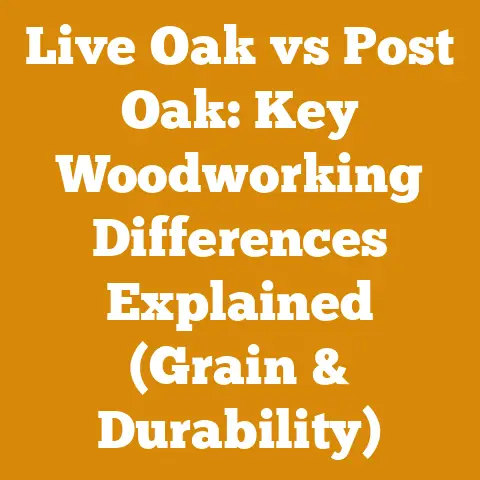DIY Boiler Build Guide (7 Expert Tips for Efficient Wood Heating)
DIY Boiler Build Guide: 7 Expert Tips for Efficient Wood Heating (and Budgeting!)
Let’s face it, the allure of a roaring wood fire on a cold winter’s night is timeless.
But as heating costs continue to climb, many of us are exploring alternative ways to keep our homes warm.
That’s where the idea of building your own wood-fired boiler comes in.
It’s a challenging project, no doubt, but incredibly rewarding.
I’ve spent years working with wood, from felling trees to processing firewood, and I’ve seen firsthand the potential for wood heating to be both efficient and cost-effective.
But before you jump in headfirst, let’s talk about the financial side of things.
Building a DIY boiler isn’t just about welding and plumbing; it’s also about smart budgeting.
This guide isn’t just about the technical “how-to” of boiler construction; it’s about understanding the costs involved and how to manage them effectively.
I’ll share seven expert tips to not only build an efficient wood-burning boiler but also to do it without breaking the bank.
We’ll delve into the nitty-gritty details of material costs, labor considerations (even if it’s just your own time!), and the hidden expenses that can easily derail a project if you’re not prepared.
Why DIY? Weighing the Costs and Benefits
Before we get into the specifics, let’s address the elephant in the room: why bother building a boiler yourself?
The most obvious reason is cost savings.
A commercially manufactured wood boiler can easily set you back several thousand dollars, even before installation.
Building your own allows you to control the costs and potentially save a significant amount of money.
However, it’s crucial to be realistic.
DIY isn’t always the cheapest option.
It requires a significant investment of time, skill, and potentially specialized tools.
You also need to factor in the cost of mistakes and the potential for unforeseen expenses.
Plus, there’s the added responsibility of ensuring your boiler is safe and efficient.
Here’s a quick breakdown of the pros and cons:
Pros:
- Potential Cost Savings: Significantly lower initial investment compared to commercial boilers.
- Customization: Tailor the design to your specific needs and heating requirements.
- Learning Opportunity: Gain valuable skills in welding, plumbing, and boiler design.
- Energy Independence: Reduce reliance on traditional heating fuels.
Cons:
- Time Commitment: Requires a significant investment of time and effort.
- Skill Requirements: Welding, plumbing, and design skills are essential.
- Potential for Mistakes: Errors can be costly and time-consuming to fix.
- Safety Concerns: Proper design and construction are crucial for safety.
- Warranty/Liability: No manufacturer’s warranty, you are responsible for its safe operation.
Ultimately, the decision to build your own boiler depends on your individual circumstances, skills, and budget.
If you’re a skilled welder with plenty of time and a knack for problem-solving, DIY might be a great option.
If you’re short on time or lack the necessary skills, a commercially manufactured boiler might be a better choice.
Tip #1: Design for Efficiency – And Budget Accordingly
The heart of any successful wood-fired boiler project is a well-thought-out design.
Efficiency isn’t just about maximizing heat output; it’s also about minimizing fuel consumption and reducing overall costs.
An efficient design will save you money in the long run by requiring less firewood.
Key Design Considerations:
- Heating Load Calculation: The first step is to determine the heating load of your home.
This is the amount of heat required to maintain a comfortable temperature during the coldest days of the year.
There are online calculators and formulas to help you estimate this, or you can consult with a heating professional.
A properly sized boiler is crucial for efficiency.
An oversized boiler will waste fuel, while an undersized boiler won’t provide enough heat. - Combustion Chamber Design: The design of the combustion chamber is critical for efficient burning.
Factors to consider include the size and shape of the chamber, the air intake system, and the type of grate.
A well-designed combustion chamber will ensure complete combustion, minimizing smoke and maximizing heat output. - Heat Exchanger Design: The heat exchanger is responsible for transferring heat from the combustion gases to the water.
Efficient heat exchanger design is essential for maximizing heat transfer and minimizing heat loss.
Consider using a multi-pass heat exchanger to increase the surface area for heat transfer. - Insulation: Proper insulation is crucial for minimizing heat loss from the boiler.
Use high-quality insulation materials to insulate the boiler body, flue pipes, and any exposed water pipes. - Draft Control: A properly controlled draft is essential for efficient combustion.
Install a barometric damper to regulate the draft and prevent excessive heat loss up the chimney.
Cost Implications:
While a more efficient design might require a slightly higher initial investment in materials, it will pay off in the long run through reduced fuel consumption.
For example, investing in a high-quality heat exchanger might cost more upfront, but it will significantly improve the boiler’s efficiency and reduce your firewood consumption.
Data Point: A study by the Biomass Energy Resource Center found that properly designed and installed wood boilers can achieve efficiencies of up to 80%.
This means that 80% of the energy in the wood is converted into usable heat.
Tip #2: Sourcing Materials – The Devil is in the Details (and the Discounts!)
The cost of materials is a major factor in any DIY boiler project.
Sourcing materials strategically can save you a significant amount of money.
Key Material Considerations:
- Steel: Steel is the primary material for building the boiler body and combustion chamber.
Look for high-quality steel that is suitable for high-temperature applications.
Consider using salvaged steel from scrap yards or industrial suppliers.
I’ve personally saved hundreds of dollars by sourcing steel from local scrap yards.
Just be sure to inspect the steel carefully for any signs of rust or damage.- Cost: New steel can range from $0.50 to $2.00 per pound, depending on the grade and thickness.
Salvaged steel can often be found for a fraction of this price.
- Cost: New steel can range from $0.50 to $2.00 per pound, depending on the grade and thickness.
- Insulation: Choose high-temperature insulation materials that are designed for boiler applications.
Rockwool and ceramic fiber insulation are good options.- Cost: Insulation can range from $1 to $5 per square foot, depending on the type and thickness.
- Plumbing Fittings: You’ll need a variety of plumbing fittings to connect the boiler to your heating system.
Use high-quality fittings that are rated for high temperatures and pressures.- Cost: Plumbing fittings can range from a few dollars to several hundred dollars, depending on the size and type.
- Pumps and Controls: You’ll need a circulating pump to circulate water through the heating system and various controls to regulate the boiler’s operation.
- Cost: Pumps and controls can range from $100 to $500, depending on the features and capacity.
Sourcing Strategies:
- Local Scrap Yards: Scrap yards are a great source of affordable steel and other materials.
Be sure to inspect the materials carefully for any signs of damage or wear. - Industrial Suppliers: Industrial suppliers often sell materials at wholesale prices.
Contact local suppliers and ask about discounts for bulk purchases. - Online Marketplaces: Online marketplaces like eBay and Craigslist can be a good source of used or surplus materials.
- Negotiate Prices: Don’t be afraid to negotiate prices with suppliers.
Many suppliers are willing to offer discounts, especially for cash purchases.
Personal Story: I once built a small wood-fired water heater using a discarded propane tank I found at a local scrap yard.
After some careful cutting and welding, I transformed it into a functional and efficient water heater.
The entire project cost me less than $100, including the cost of the welding supplies.
Data Point: According to a report by the National Association of Home Builders, material costs account for approximately 40% of the total cost of a construction project.
By sourcing materials strategically, you can significantly reduce the overall cost of your DIY boiler project.
Tip #3: Welding – Skill Pays (Literally!)
Welding is an essential skill for building a DIY boiler.
If you’re not a skilled welder, you’ll need to either learn how to weld or hire a professional welder.
Cost Implications:
- Welding Equipment: If you plan to do the welding yourself, you’ll need to invest in welding equipment, including a welding machine, helmet, gloves, and other safety gear.
A decent welding machine can cost anywhere from $300 to $1000 or more. - Welding Training: If you’re new to welding, you’ll need to take a welding course to learn the basics.
Welding courses can cost anywhere from $500 to $2000 or more. - Hiring a Welder: Hiring a professional welder can be expensive, but it might be necessary if you’re not comfortable welding yourself.
Welding rates typically range from $50 to $100 per hour.
Skill Development:
If you’re serious about building a DIY boiler, I highly recommend learning how to weld.
Welding is a valuable skill that can be used for a variety of projects.
There are many resources available to help you learn how to weld, including online tutorials, welding courses, and books.
Cost-Saving Strategies:
- Borrow or Rent Welding Equipment: If you only need welding equipment for a short period of time, consider borrowing or renting it from a friend or rental company.
- Take a Community College Welding Course: Community colleges often offer affordable welding courses that can provide you with the skills you need to complete your project.
- Practice, Practice, Practice: The more you practice welding, the better you’ll become.
Practice on scrap metal before welding on your boiler.
Data Point: According to the American Welding Society, the average hourly wage for a welder in the United States is around $20 to $30.
However, experienced welders can earn significantly more.
Tip #4: Plumbing – Don’t Get Soaked by Unexpected Costs
Plumbing is another essential aspect of building a DIY boiler.
You’ll need to connect the boiler to your heating system and ensure that the system is properly pressurized and vented.
Cost Implications:
- Plumbing Materials: You’ll need a variety of plumbing materials, including pipes, fittings, valves, and pumps.
The cost of these materials can vary depending on the size and complexity of your system. - Plumbing Tools: You’ll need a variety of plumbing tools, including pipe wrenches, pipe cutters, and soldering equipment.
- Hiring a Plumber: If you’re not comfortable doing the plumbing yourself, you’ll need to hire a professional plumber.
Plumbing rates typically range from $75 to $150 per hour.
DIY Plumbing Tips:
- Plan Your System Carefully: Before you start plumbing, plan your system carefully and create a detailed diagram.
This will help you avoid mistakes and ensure that the system is properly designed. - Use High-Quality Materials: Use high-quality plumbing materials that are designed for high temperatures and pressures.
- Follow Local Codes: Make sure that your plumbing work complies with local building codes.
- Test Your System: After you’ve completed the plumbing, test your system carefully for leaks.
Cost-Saving Strategies:
- Learn Basic Plumbing Skills: Learning basic plumbing skills can save you a significant amount of money on repairs and maintenance.
- Buy Plumbing Materials in Bulk: Buying plumbing materials in bulk can often save you money.
- Shop Around for Plumbing Supplies: Compare prices from different suppliers to find the best deals.
Data Point: According to HomeAdvisor, the average cost of hiring a plumber in the United States is around $45 to $150 per hour.
By learning basic plumbing skills, you can save yourself a significant amount of money on plumbing repairs.
Tip #5: Safety First – The Price of Prevention is Worth Every Penny
Safety should be your top priority when building a DIY boiler.
Boilers operate at high temperatures and pressures, and any mistakes can have serious consequences.
Key Safety Considerations:
- Proper Ventilation: Ensure that your boiler is properly ventilated to prevent the buildup of carbon monoxide.
- Pressure Relief Valve: Install a pressure relief valve to prevent the boiler from over-pressurizing.
- Temperature Control: Install a temperature control system to prevent the boiler from overheating.
- Regular Inspections: Inspect your boiler regularly for any signs of damage or wear.
- Fire Safety: Keep flammable materials away from the boiler and have a fire extinguisher nearby.
Cost Implications:
Investing in safety equipment and taking safety precautions might seem like an added expense, but it’s essential for protecting yourself and your property.
The cost of prevention is always less than the cost of an accident.
Safety Equipment Checklist:
- Carbon Monoxide Detector: A carbon monoxide detector can alert you to the presence of dangerous levels of carbon monoxide.
- Pressure Relief Valve: A pressure relief valve will automatically release pressure if the boiler over-pressurizes.
- Temperature Control System: A temperature control system will prevent the boiler from overheating.
- Fire Extinguisher: A fire extinguisher can be used to put out small fires.
- Safety Glasses: Safety glasses will protect your eyes from flying debris.
- Welding Helmet: A welding helmet will protect your eyes and face from the intense light and heat of welding.
- Welding Gloves: Welding gloves will protect your hands from the heat and sparks of welding.
Data Point: According to the Consumer Product Safety Commission, carbon monoxide poisoning is a leading cause of accidental deaths in the United States.
Installing a carbon monoxide detector is a simple and inexpensive way to protect yourself and your family from this deadly gas.
Tip #6: Permits and Regulations – Don’t Skip This Step (or Pay the Price!)
Before you start building your DIY boiler, it’s important to check with your local authorities to see if you need any permits or licenses.
Building codes and regulations vary from place to place, and failing to comply with them can result in fines or even legal action.
Cost Implications:
- Permit Fees: Permit fees can vary depending on the size and complexity of your project.
- Inspection Fees: You might need to pay inspection fees to have your boiler inspected by a building inspector.
- Legal Fees: If you violate building codes, you might need to hire a lawyer to defend yourself.
Research Local Regulations:
- Contact Your Local Building Department: Contact your local building department to inquire about permit requirements and building codes.
- Check Online Resources: Many local governments have online resources that provide information about building codes and regulations.
- Consult with a Professional: If you’re unsure about the regulations, consult with a building contractor or engineer.
Consequences of Non-Compliance:
- Fines: You could be fined for violating building codes.
- Stop-Work Orders: You could be issued a stop-work order, which would prevent you from continuing your project.
- Legal Action: You could be sued for damages if your boiler causes harm to someone or damages their property.
Personal Story: I once knew someone who built a wood-fired boiler without obtaining the necessary permits.
He was eventually caught by the building inspector and fined a significant amount of money.
He also had to tear down the boiler and rebuild it to comply with the building codes.
This experience taught him a valuable lesson about the importance of following local regulations.
Data Point: According to the National Conference of State Legislatures, building codes are designed to protect public health, safety, and welfare.
By complying with building codes, you can ensure that your boiler is safe and efficient.
Tip #7: Fuel Source and Storage – Planning for the Long Haul (and the Budget!)
Once your boiler is built, you’ll need a reliable source of firewood to fuel it.
The cost of firewood can vary depending on the type of wood, the location, and the time of year.
You’ll also need a place to store your firewood to keep it dry and protected from the elements.
Cost Implications:
- Firewood Purchase: The cost of firewood can range from $100 to $400 per cord, depending on the location and type of wood.
- Firewood Processing: If you plan to process your own firewood, you’ll need to invest in tools like a chainsaw, a log splitter, and a wood chipper.
- Firewood Storage: You’ll need a place to store your firewood to keep it dry and protected from the elements.
You can build a simple woodshed or purchase a pre-built firewood rack.
Firewood Sourcing Strategies:
- Harvest Your Own Wood: If you have access to a wooded area, you can harvest your own firewood.
However, you’ll need to obtain permission from the landowner and follow all local regulations. - Purchase Firewood from a Local Supplier: Purchase firewood from a local supplier.
Be sure to compare prices from different suppliers to find the best deals. - Salvage Wood from Construction Sites: Construction sites often have scrap wood that can be used for firewood.
Ask the contractor if you can salvage the wood.
Firewood Storage Tips:
- Store Firewood in a Dry Place: Store firewood in a dry place, such as a woodshed or under a tarp.
- Stack Firewood Loosely: Stack firewood loosely to allow for air circulation.
- Elevate Firewood off the Ground: Elevate firewood off the ground to prevent it from rotting.
- Cover Firewood with a Tarp: Cover firewood with a tarp to protect it from rain and snow.
Data Point: According to the U.S.
Energy Information Administration, wood is a renewable energy source that can be used to heat homes and businesses.
By using wood to heat your home, you can reduce your reliance on fossil fuels and help protect the environment.
Estimating Firewood Consumption:
To accurately budget for your firewood needs, you need to estimate your annual consumption.
This depends on several factors, including the size of your home, the climate, the efficiency of your boiler, and the type of wood you’re burning.
A rough estimate can be calculated using the following formula:
Cords of Firewood = (Heating Load in BTUs / Boiler Efficiency) / BTUs per Cord
- Heating Load: This is the total amount of heat your home needs per year, typically expressed in BTUs (British Thermal Units).
You can estimate this based on your previous heating bills or consult with a heating professional. - Boiler Efficiency: This is the percentage of energy from the wood that is converted into usable heat.
As mentioned earlier, a well-designed wood boiler can achieve efficiencies of up to 80%. - BTUs per Cord: This is the amount of energy contained in a cord of wood.
This varies depending on the type of wood.
Hardwoods like oak and maple have higher BTU values than softwoods like pine and fir.
You can find BTU values for different types of wood online.
Example:
Let’s say your home requires 100 million BTUs per year to heat, your boiler has an efficiency of 70%, and you’re burning oak, which has approximately 24 million BTUs per cord.
Cords of Firewood = (100,000,000 BTUs / 0.70) / 24,000,000 BTUs/Cord = 5.95 Cords
Therefore, you would need approximately 6 cords of oak firewood per year to heat your home.
Putting it All Together: A Sample DIY Boiler Budget
To give you a better idea of the costs involved, here’s a sample budget for a DIY wood-fired boiler project.
This is just an estimate, and your actual costs may vary depending on your specific circumstances.
Important Considerations:
- This budget does not include the cost of labor if you hire a professional welder or plumber.
- This budget assumes that you have some basic tools and equipment already.
- This budget is just an estimate, and your actual costs may vary.
- Contingency fund: Always add a contingency fund of 10-20% to cover unexpected expenses.
Final Thoughts: Is DIY Right for You?
Building a DIY wood-fired boiler is a challenging but rewarding project.
It requires a significant investment of time, skill, and money.
However, if you’re willing to put in the effort, you can save a significant amount of money on heating costs and gain a greater sense of energy independence.
Before you start your project, be sure to do your research, plan carefully, and follow all safety precautions.
And remember, the key to a successful DIY boiler project is to manage your costs effectively.
By following the tips in this guide, you can build an efficient and affordable wood-fired boiler that will keep your home warm for years to come.
Remember, the journey of a thousand miles begins with a single step.
So, gather your tools, sharpen your skills, and get ready to embark on this exciting adventure!
And don’t forget to share your experiences and lessons learned with others.
The DIY community is a valuable resource for sharing knowledge and supporting each other.
Happy building!






